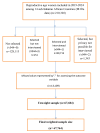Domestic violence and its determinants among reproductive-age women in Sub-saharan Africa: a multilevel analysis of 2019-2024 demographic and health survey data
- PMID: 40604804
- PMCID: PMC12220315
- DOI: 10.1186/s12889-025-23544-z
Domestic violence and its determinants among reproductive-age women in Sub-saharan Africa: a multilevel analysis of 2019-2024 demographic and health survey data
Abstract
Background: Domestic violence is a global health issue that impacts health policies and initiatives, as well as women's health, reproductive outcomes, and family well-being. It violates human rights, hinders gender equality, and requires a multifaceted approach. Studies in sub-Saharan Africa (SSA) reveal significant disparities across nations. This study utilizes data from the 2019-2024 Demographic and Health Survey (DHS) to determine the prevalence of domestic violence among reproductive-age women in Sub-Saharan African countries and its associated factors.
Methods: A cross-sectional study design was used through multilevel logistic regression analysis. A total of 67,764 women aged 15-49 were included in the study. To ensure representativeness, weighted estimates were applied in the analysis using STATA version 17. Statistically significant variables were identified using adjusted odds ratios (AOR) with a 95% confidence interval (CI).
Results: The overall prevalence of domestic violence among reproductive-age women in sub-Saharan African countries was found to be 38.14% (95% CI: 37.78-38.51). The highest and the lowest prevalence of domestic violence were observed in Sierra Leone and Mauritania, 60.72% and 18.70%, respectively. Across regions, the highest prevalence of domestic violence was observed in Central Africa (45.7%), while the lowest prevalence was observed in West Africa (35.34%). Factors associated with domestic violence included justifying wife beating, witnessing mother beaten by father, education status, current working status, smoking tobacco, marital status, being afraid of their partner, and having a partner who exhibited jealousy when the respondent talked with other men. In contrast, age (15-29 years old) is protective against domestic violence. Residence, media exposure, and regions were also community-level factors associated with domestic violence.
Conclusion: The prevalence of domestic violence among reproductive-age women in sub-Saharan African countries is high. Individual and community-related factors contribute significantly to violence. Strengthening legal protections, economic and social empowerment of women, and implementing community-based education programs for partners are recommended to reduce domestic violence in sub-Saharan African countries.
Keywords: Domestic violence; Multilevel analysis; Risk factors; Sub-Sahara Africa; Women.
© 2025. The Author(s).
Conflict of interest statement
Declarations. Ethical approval and consent to participate: All methods were conducted according to the ethical standard of the declaration of Helsinki. Since this study is a secondary analysis of publicly available and anonymized data from multiple sub-Saharan African countries, no additional ethics approval was required. The data were obtained from the Demographic and Health Survey Program repository with permission after submitting a request and providing a detailed explanation of the study’s purpose. The Demographic and Health Surveys are conducted by national statistical agencies in collaboration with ICF International. Ethical approval for data collection was obtained from the national ethics committees of each participating country and ICF International, ensuring compliance with ethical standards. Informed consent was obtained from all participants during data collection. The datasets are fully de-identified and do not contain any personally identifiable information. https://dhsprogram.com/publications/publication-FR391-DHS-Final-Reports.cfm . Consent for publication: Not applicable. Competing interests: The authors declare no competing interests.
Figures
Similar articles
-
Overnutrition and associated factors among women of reproductive age in Sub-Saharan Africa: A hierarchical analysis of 2019-2023 standard demographic and health survey data.Nutrition. 2024 Dec;128:112563. doi: 10.1016/j.nut.2024.112563. Epub 2024 Aug 24. Nutrition. 2024. PMID: 39303379
-
Gender differences in the acceptance of wife-beating: evidence from 30 countries in Sub-Saharan Africa.BMC Womens Health. 2023 Aug 27;23(1):451. doi: 10.1186/s12905-023-02611-w. BMC Womens Health. 2023. PMID: 37635210 Free PMC article.
-
Unhealthy food consumption and its determinants among children aged 6 to 23 months in sub-Saharan Africa: a multilevel analysis of the demographic and health survey.BMC Pediatr. 2024 Jan 13;24(1):40. doi: 10.1186/s12887-023-04514-z. BMC Pediatr. 2024. PMID: 38218821 Free PMC article.
-
Prevalence and Genotype Distribution of High-Risk Human Papillomavirus Infection Among Sub-Saharan African Women: A Systematic Review and Meta-Analysis.Front Public Health. 2022 Jul 8;10:890880. doi: 10.3389/fpubh.2022.890880. eCollection 2022. Front Public Health. 2022. PMID: 35875040 Free PMC article.
-
Prevalence of vision impairment among patients with diabetes mellitus in sub-Saharan Africa: A systematic review and meta-analysis.PLoS One. 2025 Jun 24;20(6):e0326176. doi: 10.1371/journal.pone.0326176. eCollection 2025. PLoS One. 2025. PMID: 40554578 Free PMC article.
References
-
- World Health Organization. Understanding and addressing violence against women: intimate partner violence. Geneva: World Health Organization; 2012.
-
- Devries KM, Mak JY, García-Moreno C, Petzold M, Child JC, Falder G, et al. Global health. The global prevalence of intimate partner violence against women. Science. 2013;340(6140):1527–8. - PubMed
-
- García-Moreno C, Jansen H, Ellsberg M, Heise L, Watts C. WHO multi-country study on women’s health and domestic violence against women. Geneva: World health organization. 2005;204(1):18.
MeSH terms
LinkOut - more resources
Full Text Sources
Research Materials



